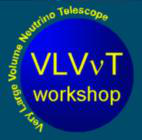Description
Chairs: Luciano Moscoso (APC Paris): Morning Session, Luke Drury (IAS Dublin): Afternoon Session
Marco CIRCELLA
(INFN Bari)
22/04/2008 09:30
ANTARES (Astronomy with a Neutrino Telescope and Abyss environmental RESearch) is the largest neutrino detector currently operating in the Northern Hemisphere. The detection principle relies on the observation of Cerenkov light emitted by muons resulting from charged current neutrino interactions in the water surrounding the detector and the seafloor below. The full apparatus will comprise...
Elisa RESCONI
(MPI Heidelberg)
22/04/2008 10:10
The IceCube neutrino observatory, under construction at the South Pole, consists of three sub-detectors: a 3-dimensional array of digital optical modules deployed deep in the ice, the AMANDA neutrino telescope and the surface array IceTop. I will summarize results from searches for cosmic neutrinos with the AMANDA telescope and review expected sensitivities for IceCube at various installation...
Vladimir AYNUDTINOV
(R.A.S. Moscow)
22/04/2008 11:20
We review the status of the Baikal Neutrino Telescope, which is operating in Lake Baikal since 1998 and has been upgraded to the 10 Mton detector NT200+ in 2005. We present selected physics results on searches for upward going neutrinos, relativistic magnetic monopoles and for very high energy neutrinos. Recent results of R&D activities towards a km3 Baikal neutrino telescope are discussed
Paolo FAVALI
(INGV Rome)
22/04/2008 11:50
Plenary talk
EMSO is a Research Infrastructure listed within ESFRI, and will be based on a European-scale network of multidisciplinary seafloor observatories from the Arctic to the Black Sea with the scientific objective of long-term real-time monitoring of processes related to geosphere/biosphere/hydrosphere interactions. GMES has identified a need for a seafloor segment complementary to land and space...
Arache DJANATTI-ATAI
(APC Paris)
22/04/2008 14:00
Plenary talk
After more than 2 decades of gestation the atmospheric chernkov technique has reached the maturity age. Obsevations in the very high energy gamma-ray band with the new generation of imaging telescopes, in particular the galactic plane scan by HESS, low threshold observations with MAGIC and more recently operation of VERITAS, have revealed few tens of sources in the galactic and extragalactic...
Etienne PARIZOT
(Paris-7)
22/04/2008 14:30
Plenary talk
The current status of the Pierre Auger Observatory will be described and the main results gathered so far about arrival directions, energy spectrum and composition will be presented, including the current limit on the high-energy neutrino flux. Implications for the future development of high-energy cosmic ray astrophysics will also be discussed.
Ulrich KATZ
(Friedrich-Alexander Universitat Erlangen-Nurnberg)
22/04/2008 15:00
KM3NeT is a future research infrastructure in the Mediterranean Sea, hosting a cubic-kilometre-scale neutrino telescope and nodes for associated sciences such as marine biology, oceanology and geophysics. The status of the KM3NeT project and the progress made in the EU-funded Design Study will be reviewed. The KM3NeT Conceptual Design Report (CDR), summarising the design options to be further...
Prof.
Antonio CAPONE
(Physics Department, University "Sapienza" and INFN, Roma)
22/04/2008 15:30
Plenary Session
Plenary talk
The NEMO collaboration has conducted in the recent years an intense R&D activity directed at the realization of an underwater km3 Cherenkov detector for the detection of high energy astrophysical neutrinos. The activities have addressed some key issues such as the search and characterization of an optimal deep-sea site for the detector installation, the definition of the detector architecture,...
Petros RAPIDIS
(INP Demokritos, Greece)
22/04/2008 16:30
The NESTOR collaboration is continuing its efforts towards deploying a larger portion of its proposed tower detector. Following the successful deployment of a single floor of the tower in 2003, five floors are now in the final stages of preparation. These floors, together with two autonomous strings to be located some 300 m away from the tower form the detector proposed by the NuBE...
Prof.
Zhi-Zhong XING
(Institute of High Energy Physics, Chinese Academy of Sciences)
22/04/2008 17:00
If the ultrahigh-energy (UHE) neutrino fluxes produced from a distant astrophysical source can be measured at a km^3-size neutrino telescope, they will provide a promising way to help determine the flavor mixing pattern of three active neutrinos.
Considering the conventional UHE neutrino source with the flavor ratio \phi_e : \phi_\mu : \phi_\tau = 1 : 2 : 0, I will show that \phi_e :...
Stephen M. TAYLOR
(Ocean Networks Canada)
22/04/2008 17:30
The health of the world’s oceans and their impact on global environmental and climate change make the development of cabled observing systems vital and timely as a data source and archive of unparalleled importance for new discoveries. The VENUS and NEPTUNE Canada observatories are on the forefront of a new generation of ocean science and technology. Funding of over $100M, principally from the...

